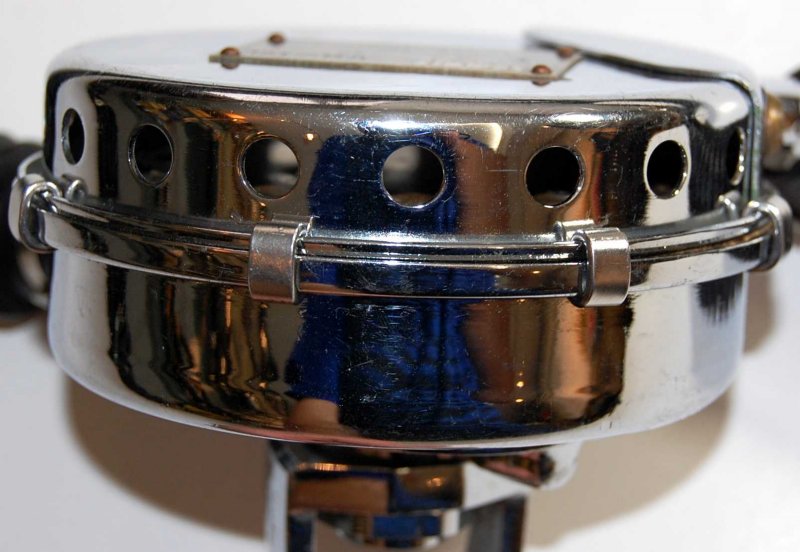By mid-1947, Frenchman Emile Gagnan had immigrated to Canada under the patronage of the Canadian subsidiary of L’Aire Liquide, Canadian Liquid Air Ltd. (CLA).
The place chosen for Gagnan to set up his laboratory was Montreal, in the French-speaking province of Quebec. Then his family also came to live in January 1948.
History
By mid-1947, Frenchman Emile Gagnan had immigrated to Canada under the patronage of the Canadian subsidiary of L’Aire Liquide, Canadian Liquid Air Ltd. (CLA).
The place chosen for Gagnan to set up his laboratory was Montreal, in the French-speaking province of Quebec. Then his family also came to live in January 1948.

The company Spirotechnique S.A.R.L. (Societe Anonyme Responsabilitie Limitee), a division of L’Aire Liquide, was created in 1946 to produce and market the CG-45 regulator in France. In 1947 it was restructured by the chief executive of L’Aire Liquide, Jean Delorme, and became a SA – Sociedad Anônima – although 99% of the company’s shares belonged to L’Aire Liquide and the rest (1%) was property of Jacques Yves Cousteau.
The largest US economic partner at that time was Canada, which had a good business relationship with the Americans. The perfect place for the SCAPHANDRE AUTONOME to be assembled and exported to the USA. But the name in French did not have a pleasant pronunciation in the English language, which led the company to look for a better American name. And more than that, the company has sought a name with a Spanish style that appealed to the consumers of the State of California; the place that the company had detected with the greatest market potential. The name AQUA-LUNG was born.
Gagnan’s laboratory in Montreal received the first major request from regulators of the Department of Defense of the Canadian Government. The parts and pieces were shipped from France and assembled in Canada. The only differences from French regulators were on labels.
The units that were destined for the Fleet Diving Unit Pacific were produced with the labels containing “Canadian Liquid Air Co. Ltd.” and were sold through the CLA plant in Vancouver, BC.
The Aqua-Lungs for the Fleet Diving Unit Atlantic had the nameplates “Aire Liquide Canada” and were supplied by the Montreal industrial plant.
Both labels had the inscription “Made in Canada” which would not cause economic difficulties for the commercialization of these units in the American market, due to the commercial partnership existing between the countries. Phil Nuytten, author of the research and excellent story in Historical Diver magazine, says many collectors of double hose regulators believe that “made in Canada” regulators had metric measurements, different from the American measurement system. Phil disagrees with this and reports that regulators presented the same system of measures as regulators subsequently produced in the US.
The regulators also brought in their labels the contract number of the Canadian Liquide Air project.
A third “Made in Canada” identification label, too, was stamped by Canadian Air Liquide. A model containing “SPACO-BURLINGTON, VERMONT. MADE IN CANADA”
SPACO Incorporated was a company with offices in New York and was engaged in the representation of a wide variety of foreign products. SPACO, after negotiations with Spirotechnique and L’Aire Liquide in 1948, officially represented Aqua-Lung on the east coast and distributed it.
In 1949, Spaco Incorporated, of Burlington, Vermont, began a timid distribution of Aqua-lungs regulators. The search for resellers on the East Coast occurred in the course of 1949, as well as direct sales to interested parties.
One of Spaco’s largest resellers was the famous New York sporting goods company, Abercrombie and Fich., Which had previously imported some copies of Aqua-Lungs to the US from Canada. The company was not interested, due to its retail activity, to seek the exclusive distribution of the new product. In addition, SPACO has hit dealers in several US East Coast states.
On the west coast of California, a small Los Angeles sportswear company, Rene Sports, had successfully marketed equipment for free diving and underwater hunting, especially arbalates, which French owner Rene Bussoz imported from French manufacturers.
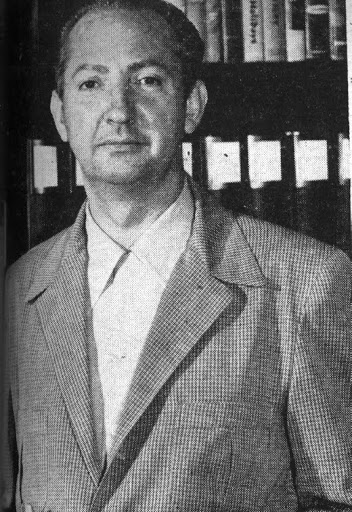
In his book DIVING PIONNERS – AN ORAL HISTORY OF DIVING IN AMERICA, Eric Hanauer sought to detail the history of the beginning of the dive in the USA through the testimonies and interviews with some pioneers of the activity in that country.
He tells that Rene Bussoz, a Frenchman who immigrated to the United States during World War II, opened Rene’s Sporting Goods in Westwood, near the UCLA campus.
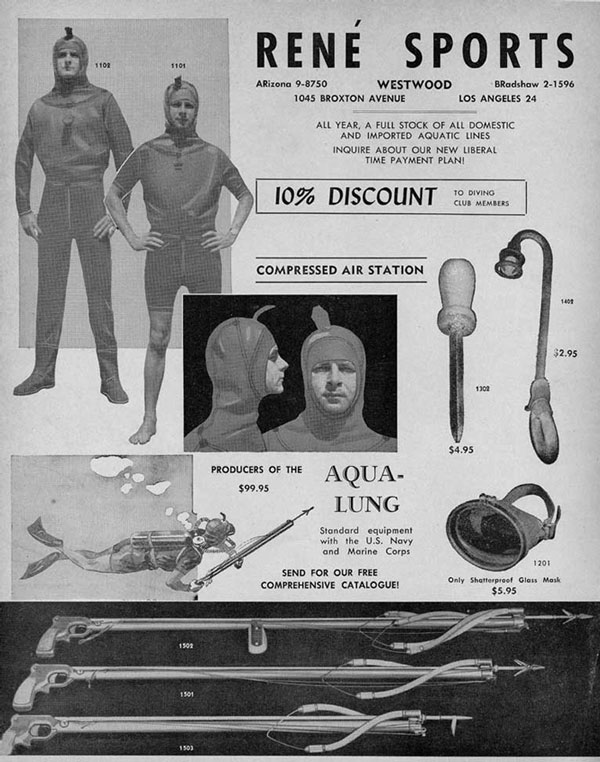
The main reason for diving was the practice of spearfishing. In the 1950s, books and magazines featured pictures of scuba divers with dead animals / fish in their articles on diving.
Underwater hunting by pioneers of diving activity should be regarded as a historical legacy. The stories told, “exploits” and articles of the time about the spearfishing activity should not be judged from the perspective of the current environmental ethics. We must remember that the coastal population was small and there was not the environmental feeling of today’s divers.
He reports in the book that Glen McCall, who was a free-diving practitioner, did some work for Rene’s company. In his testimony, Glen reports that in 1949 Cousteau brought six Aqua-Lungs to Westwood. The plan was to show Rene and his staff how to use the equipment and helps to introduce the new sport to potential customers.
Glen writes that René rented a boat from Bob Vincent and headed for Point Dume. The divers on board were: Cousteau, Bussoz, Vincent, McCall, another Frenchman, who Glen does not remember the name, and Johnny Weismuller. John Weismuller, the Tarzan from the movies and Rene’s friend, was invited to the first dive and became a fan of the activity.
Glen says the only thing he remembered about that dive was to have been a little afraid of the little sharks they encountered on the spot.
The first Aqua-Lungs were in the store for about six to ten months, where Rene lent them to potential customers. Glen and Bob Vincent bought two of the six original units, which included the regulator and cylinder assembly.
After that, the units were shipped from France in parts (the fractional shipment was more economical) and were assembled by McCall – which can be considered the first production line of American regulators.
At this time, the difficulty of obtaining cylinders was great, which led to the acquisition of fire extinguisher cylinders from Walter Kidde company, connected to oxygen valves.
Glen names some of the first clients in Eric’s book: Parry Bivens, Mel Fisher and Bob Lorenz. Bob opened the first US Dive Shop, the WaterGill in Venice. Mel Fisher opened the second Dive Shop in Redondo Beach, Mel’s Aqua Shop.
Glen says that Buster Crabbe, another Olympic swimmer and Flash Gordon in the movies, was also one of the first owners of an Aqua-Lung.
Rene Bussoz was aware of the sale of the Aqua-Lungs on the East Coast and had already received some demand from his customers for the new equipment. He made the decision to sell the equipment on the west coast of the USA and began making contacts with French suppliers, among them Rene Cavalero, prodcuerer of spearguns. Rene approached Spirotechnique and showed interest in importing Aqua-Lungs to the American West Coast. Spirotechnique tried to direct the operation to its SPACO distributor, but Rene did not accept it.
Due to the great market potential of the US West Coast and, with Rene showing his great commercial ability, “threatening” to import the competing equipment, the COMMEINHES GC42 AMPHIBIE (equipment already used by the French Navy), Spirotechnique agreed to negotiate with Rene Bussoz.
With the start of negotiations, L’Aire Liquide begins research into Rene Bussoz’s financial resources and learns that he was negotiating with the owner of a sporting goods store. Spirotechnique has always been planning to open a factory in the US and choosing SPACO might not have been the best option.
Rene Bussoz, a skilled negotiator, offers an irrecusable offer. The duly insured purchase guarantee of 11 million French Francs (approximately US $ 2 million) for the import exclusivity of the Aqua-Lungs to the US for a period of six years. A value far greater than a contract of representation at that time.

So, after six years L’Aire Liquide could renew the representation for a much greater value if Bussoz succeeded and, if it did not, the sale of 11 million French Francs was assured. A very attractive deal for the company and its subsidiary Spirotechnique. They relinquished the great Amercian market for 11 million French Francs and still had the rest of the world to negotiate.
The money for the business collateral came from the Bank of California in the form of a secured loan to the U.S. Divers Co., the new company that Bussoz had opened just before the start of negotiations.
In the late 1950s, US Divers Co., located at the same address as Rene Sports – 1045 Broxton Ave in Westwood – Los Angeles, had closed the license exclusivity with Spirotechnique and the guarantee that no one else would import, manufacture or distribute Aqua -Lung in the USA. The right belonged to Rene Bussoz.
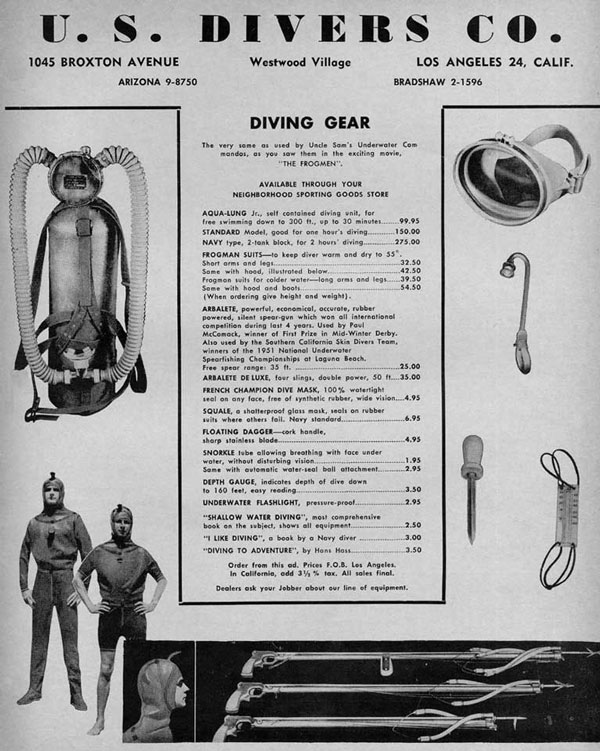
When Rene Bussoz created the US DIVERS company and registered the name Aqua-Lung, he had no idea how accurate this measure had been.
With the agreement finalized and signed, Rene begins to think like a distributor and no longer a simple reseller. Its margins are now smaller and sales volume should increase to maintain the same profitability in business. The cost of an Aqua-Lung for him, consisting of the regulator CG45 + Tank + Valve + Harness, and the price was $ 56. The price for a dealer was $ 85 and the retail price was $ 140. This was a big problem for a product where most resellers had no ability to absorb an order of various Aqua-Lungs.
Once again, Rene demonstrated his great ability in business. He decided that there would be no exclusive resellers, and in the spring of 1951, all his price lists had a box with the words:
“WHOSALE DISCOUNTS”
“AQUA-LUNG: ON SHIPMENT OF ONE UNIT: 25%, ON SHIPMENT OF THREE: 33%, ON SHIPMENT OF SIX: 40%”
In other words, anyone could become a reseller (with a 40% margin) by buying 6 or more Aqua-Lungs. A sales innovation compared to other brands.
The first Aqua-Lungs that Rene Bussoz sold at his store in 1949 came from Canada. He had already bought some units from France, but high customs fees made the importation of that country impracticable. Rene found out that the importation of parts and pieces were more advantageous than the importation of assembled regulators, since the import tax was lower.
He also discovered that the discount that would be given for the value of the regulator’s assembly labor in Canada was greater than the amount he would spend for its assembly in the USA.

Bussoz contacted Gagnan and started to order Aqua-Lungs in parts and pieces and started to assemble in the USA, with a total lower cost than the importation of regulators already assembled.
During the period from 1948 to 1951, there were five models of the French CG-45 regulator that were made available to the American market:
• The original CG-45, purchased directly from Spirotechnique from France, with the label containing La Spirotechnique S.A.;
• After 1947, the original CG-45 was also available from Montreal in Canada. And in 1948, a new nameplate was placed on the French version containing L’Aire Liquide Canada – made in Canada;
• Shortly thereafter, a version containing Canadian Air Co. Ltd. – made in Canada;
• In 1949, the available label contained the expression SPACO, as we have seen above;
• With the agreement signed with Rene Bussoz, one last label was produced containing the expression U.S. Divers Co. – 1045 Broxton Ave., Los Angeles;
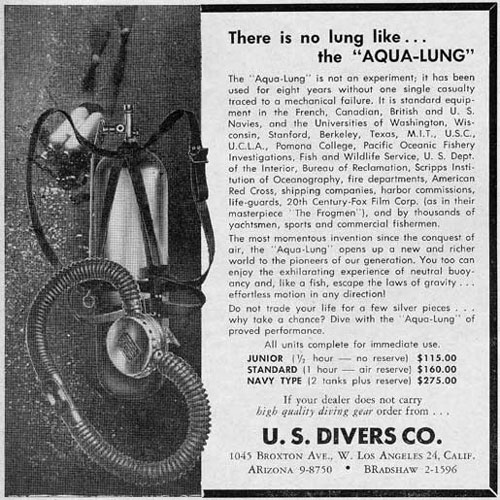
When Sam Lecocq – a Frenchman who participated in the French Resistance and has dived in the many wrecks of the Normandy coast – joined US Divers Co. in 1952, Rene Bussoz was beginning to manufacture Aqua-Lung in the USA. Bussoz had an agreement with L’Aire Liquide to pay a royalty of 50 cents per unit to have the right to use the product brand in the USA.
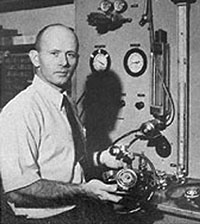
Sam was sent to Skokie, Illinois, for giant Bastian and Blessing Co., manufacturers of all types of regulators and pressure valves, which was contracted to manufacture the first American Aqua-Lung. Sam was in charge of establishing the manufacture and supervised the initial production.
The company grew so fast that, in 1955, Bussoz changed the U.S. Divers to a new address, 11201 West Pico Blvd. and closed the Rene Sports. U.S. Divers sold more than 50,000 units in 1955 and 1956. The few sales of a few hundred units in the first year passed to tens of thousands of regulators by the end of the company’s sixth year. But the exclusivity of the contract with Spirotechnique came to an end in 1956.
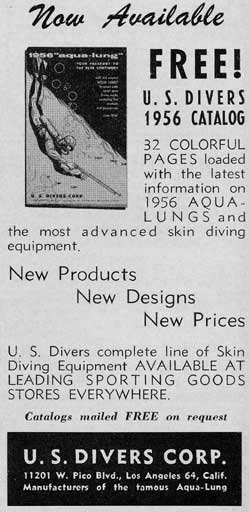
At the end of 1956, L’Aire Liquide informed Bussoz that it had no intention of renewing its exclusivity concession and that it had an interest in acquiring the U.S. Divers plant. Rene responded by saying that the company belonged to him and reported that U.S. Divers was the owner of the Aqua-Lung trademark rights in the USA. Bussoz said he would continue production of regulators and that he would negotiate with other manufacturers of US regulators and that one of them would be chosen to become the U.S. Aqua-Lung Divers.
Another master move!
Gagnan, who had great prestige along with Rene, is called to continue the negotiation, since Bussoz refused to continue talking with the executives who were trying to harm him. As a result, L’Aire Liquide and Spirotechnique spent $ 3 million to acquire U.S. Divers Corporation. In early 1957, the documents were signed and Jacques Yves Cousteau was announced as the chairman of the company’s board of directors.
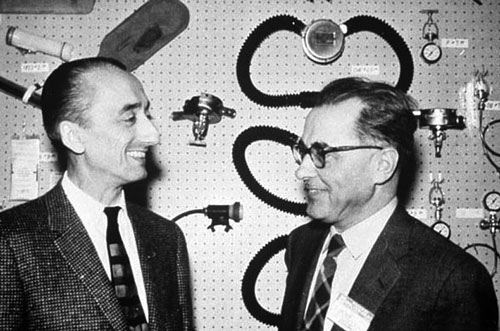
Rene Bussoz returned to France and enjoyed all the success he has achieved in his diving career and excellent entrepreneur.
In 1956, in his book FREE DIVING, Dimitri Rebikoff’s related all the existing dive clubs in the USA, showing that, although SCUBA equipment was born in France, it found a great acceptance in American soil. Rebikoff’s counted 132 diving clubs in California, 32 in New York and 24 in the State of Florida.
In 1960, U.S. Divers changed its address to 3323 West Delhi Ave. – Santa Ana – California. In 1961, the name of this street was changed to West Warner Avenue, and West Delhi Ave. ceases to exist on the maps of Santa Ana.
Keeping on the market to this day, US Divers, a subsidiary of the Aqua-lung group, formerly La Spirotechnique, has produced varied equipment for diving activity. The double hose regulators were manufactured until 1972. The company produces single hose regulators until today.
The name US Divers always sounded very official and very American, but was founded by a Frenchman and was sold to a French company.
US Divers remains a milestone in history and a benchmark in the world of diving.
Production of double hose regulators by US Divers in the timeline:
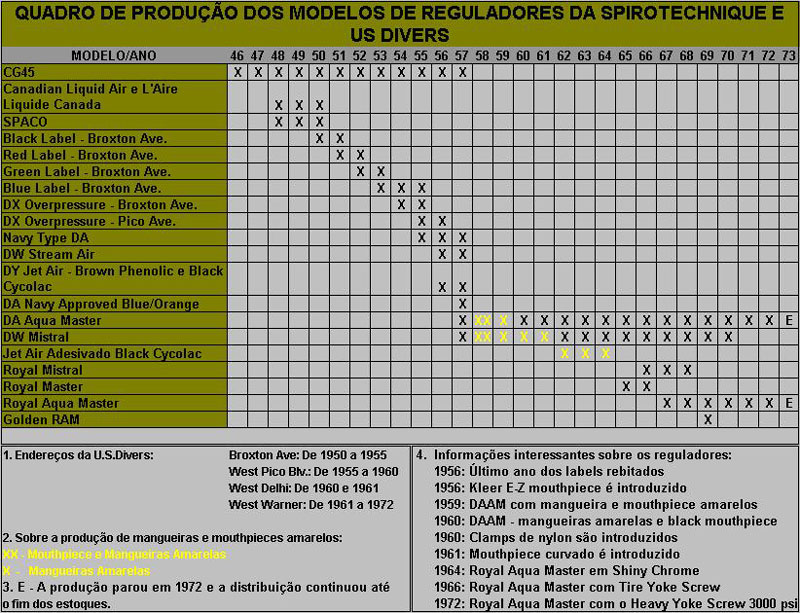
Reference
- Historical Diver – Volume 13 Issue 1 – Number 42, Winter 2005 – Emile Gagnan and the Aqua-Lung 1948-1958 – By Phil Nuytten
- http://www.bichodomar.com/index.php/90-nostalgia/reguladores-2-traqueias/94-us-divers
- Diving Pionneers – An Oral History of Diving in America: By Eric Hanauer
- http://www.internationallegendsofdiving.com/Articles/miller_072705.htm

